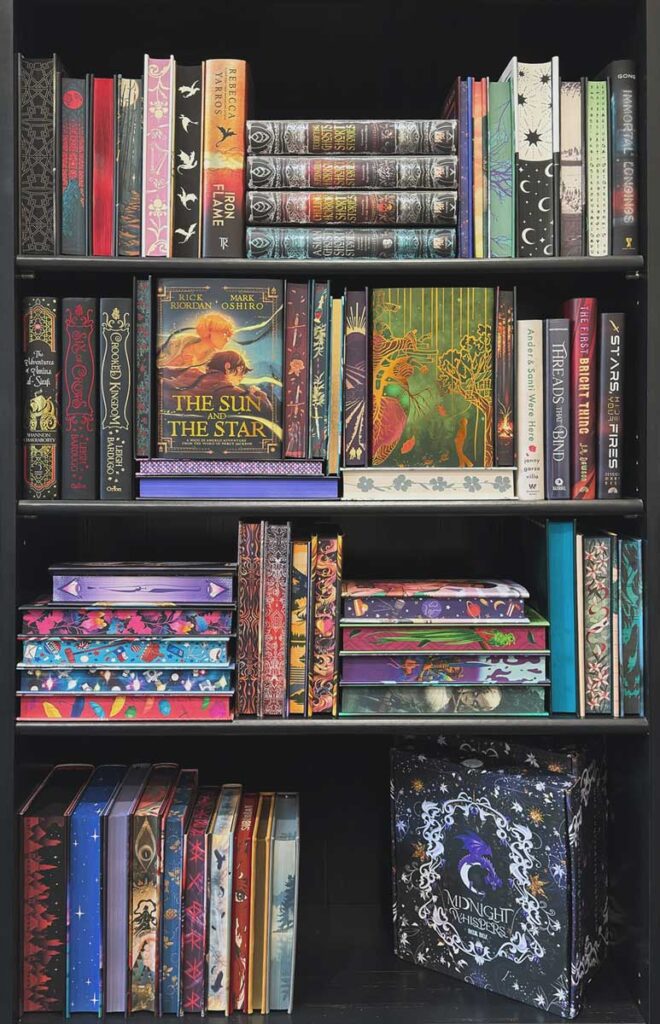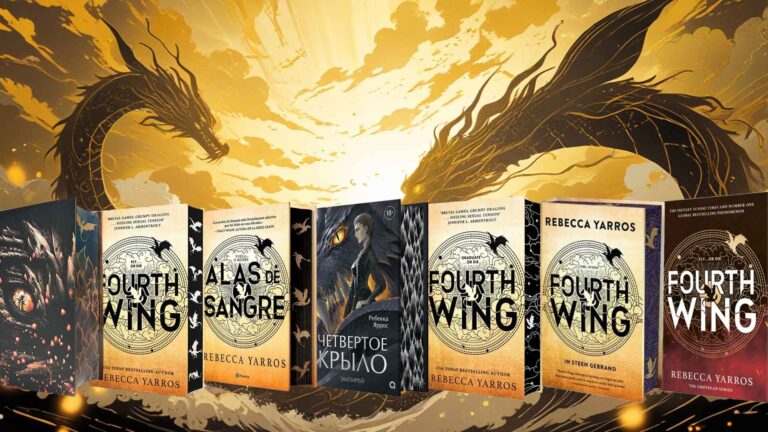The Explosion of Special Feature Books: Why Collectors and Readers are Getting into Preordering First Editions
Published by Daisy on
The Explosion of Special Feature Books
How and why the book market is flooding with "unique" first printings
Please note that some of the links below are affiliate links for which I may be compensated (this does not affect my reviews nor cost you any money, but helps support my site hosting costs). I deeply appreciate your support of my site if you use these links, but warmly encourage you to buy from your local Indie bookshop if you have the opportunity.
What’s Going On?
You may have noticed that over the past couple of years, the book publishing industry has witnessed a crazy surge in the production of special feature books. I’ve certainly noticed – my page that tracks upcoming special editions got sooo loooong that I had to reconfigure it a few weeks ago into separate monthly lists.
These “deluxe” “special” “collector’s” editions come with a range of unique features designed to make them stand out. From stunning decorative sprayed page edges to foiled designs hidden under the dust jacket, from bespoke endpapers to gorgeous illustrations and exclusive bonus content, these special features can transform ordinary books into extraordinary treasures.
By limiting many of these special elements to first printings, publishers are creating a sense of exclusivity and urgency among collectors.
Now, I love all these bells and whistles and having them in my shelves brings me great joy, but as a long time collector I want to remind you not to get too stressed if you miss out on an edition. Secondary market prices are wild, and I promise you there is bound to be another gorgeous book coming along tomorrow that you can enjoy without promising your first-born to a neighbouring witch.

The Allure of Special Editions
Aesthetic Appeal: Let’s be honest, who doesn’t love a book that looks as good on the outside as it does on the inside? Special edition books are visually striking. Decorative features like sprayed page edges and foiled designs are like candy for the eyes, they add a touch of magic to your reading, and they can transform your bookshelves into mini walls of art.
Marketing Strategy: Publishers are smart – they know we love something exclusive. By limiting these features to first print runs, they create a sense of urgency. Fear of missing out, or FOMO, drives preorders and early purchases, ensuring strong initial sales.
Pros and Cons for Collectors
Pros:
- Exclusivity: First print runs with special features are usually limited in number, which can make them rare and valuable. And owning a first print edition with special features can feel like being part of a secret club – it’s something only other booklovers will have and appreciate.
- Increased Value: Over time, some of these special editions can become highly sought after in the secondary market, potentially increasing in value. In my experience though, after the hype wanes they can equally plummet in value (look at all those Fourth Wing editions, each one cannibalising the others’ market share) – so buying these as an investment can be a very dicey proposition.
- Enhanced Reading Experience: The added features can make the reading experience more enjoyable and memorable. I especially love checking under the dust jacket and finding a hidden treasure!
Cons:
- Availability Issues: Limited print runs may mean that not everyone who wants a special edition can get one, leading to disappointment and frustration. Some of the books are “geolocked” and hard to source if you’re living outside the US and UK, leading to expensive shipping and more carbon emissions. Others go on sale at a particular time, leading to anxiety and stress about missing the sale window, or preordering a book you end up not really liking.
- Higher Cost: Some special editions are more expensive than standard editions, which of course can pose a barrier for some collectors.
- Quality Issues: Some publishers spend time and effort publishing beautiful quality books that you can hand down across generations. Others are using low quality spray on glued textblocks that will fade and fall apart. Look for publishers you can trust (e.g. I’m reading some LitJoy special editions right now that are delightful and well constructed (review to come!), while I have another special edition hardback from Waterstones on my bedside table that literally faded while I read it in the sun for just a few hours. I want my books to be readable people!).
- Storage: Collectors want to ensure these special editions are stored properly to maintain their condition, which can require additional resources and care. Books take up quite a bit of space, and if you decide to collect a prolific title or author this doesn’t take long to get out of control (guilty! haha).
First editions, first printings, and all that jazz
If you imagine getting your hands on a book right when it first hits the shelves, that’s what a “first edition” book is. It’s the initial publication of a book, whether it’s in hardcover, paperback, a limited edition, or a special release. This version is the book’s debut to the world.
A “first printing” refers to the very first batch of copies produced from the first edition. Think of these like the first batch of cookies fresh out of the oven from a new recipe. The books have gone through the entire “baking” process from the initial manuscript “ingredients” to the final bound copies ready for readers to enjoy. Sometimes, the first printing can have unique features like printing variations or errors that were later corrected.
For book collectors, there is usually a preference for first printings of first editions, as these are seen as the most authentic and significant versions of a book (and typically the most valuable). And when special features are included only in the first print run, of course they become even more sought after.
How “exclusive” are they, really?
A typical first print run can vary widely depending on the expected demand for the book. For a debut novel or an author’s first work, the print run might be relatively small, ranging from around 2,000 to 20,000 copies. Larger announced print runs can be a marketing tactic to indicate high demand, but they may actually print far fewer copies (e.g. I know publishers who announced a print run of 80k, although they printed only 10k to start with). Publishers tend to be pretty conservative these days, as it’s not hard to go back for a reprint. For established authors or highly anticipated titles, initial print runs can be significantly larger, sometimes exceeding 100,000 copies. Michelle Obama’s Becoming, for example, had such a high number of preorders (allegedly in the millions) that it had to be printed at multiple plants and disrupted many other books scheduled for print at the same time. The goal is to balance the risk of unsold inventory with the potential for high demand, adjusting print numbers accordingly to maximize both availability and profitability.
You’ll really only know how exclusive the books are if the publisher numbers them, which is usually the case only with certain publishers and low limitations. Some bookclubs like Goldsboro release numbered special editions so you know exactly how many copies they release of their book club titles (it was 500 copies back in 2005, these days between 1500 to 2000). Waterstones typically prints between 1000-2000 copies of its special editions as well, although they are not numbered. Clubs like FairyLoot and Illumicrate don’t share how many they print, but based on information from authors who’ve had to sign tip-in sheets, the print run is likely between 2000-5000 copies of their standard club titles.

US vs. UK Trends and Beyond
UK Market: The UK market has has long been a stronghold for special edition mass market books. Early on, British special edition books were usually characterised by aesthetic features like illustations endpapers, ribbon bookmarks and bespoke splicases. My first purchases in this area were from Independent publishers like The Folio Society (1066 And All That had ink spattered page edges way back in 1990). And Indie bookstore Goldsboro Books was adding special features like alternate covers, slipcases and sprayed page edges to its “Book of the Month” club back in the early noughties. Waterstones bookshop has been known for its special editions for many years, and Independent bookshops in the UK frequently collaborate with publishers to create bespoke editions. Well-known special edition book clubs like Illumicrate and FairyLoot were some of the earliest drivers of the current “book subscription box” phenomenon, and these were established back in 2015/2016 by booklovers.
Finding special editions
If there are authors of publishers that you particularly love, then I recommend signing up to their newsletters and social media channels to get information about upcoming special editions as soon as they announce them. Otherwise, as I mentioned earlier, I have been sharing information about special editions for years, and you can check out both upcoming releases as well as archives going back for more than half a decade on the upcoming special editions page linked below:

4 Comments
Iris · 28 April 2025 at 3:12 pm
Hi! I’ve been wondering this and wanted to get your opinion. There have been so many special editions lately that are published concurrently with first editions, like Waterstones or The Broken Binding editions. Which will hold more value in the long run? The regular first edition first printing or the ones with all the bells and whistles that are supposedly also considered first editions? Are the true first editions the regular editions? Thanks for your input!
Daisy · 30 April 2025 at 6:54 am
Such a great question! There’s no magic solution to predicting future values unfortunately, but my best guess would be based on a combination of scarcity, aesthetics and notoriety. ‘True’ first editions will be whichever edition is published first (that could be a special edition if they are released pre-publication date, but will usually be the trade edition). Some of the special editions will be a subset of this category e.g. Goldsboro special editions are specifically listed as being 1/1 – meaning first edition, first printing – and several of the publisher special editions (e.g. Fourth Wing with dragon edges) are only available on first printings so they are also 1/1. As you note, true firsts have historically been the most valuable. Other special editions might not be the first printings (not all my Waterstones special eds are 1/1, for example) but there’s no hard and fast rule. Next you need to consider scarcity, some special editions might have limited print runs, maybe only a couple of hundred copies – this can drive up value because collectors may be competing for a small ‘pot’ of resources. You often find this with resale of speciality press books like Subterranean Press for popular titles – collectors can pay far over release price to get the copy they want. Aesthetics is hard to predict (obviously every design is trying to be desirable), but some designs just happen to resonate at the time (Fourth Wing drove people into a frenzy) or can hold value over decades (I have an article on the original Cranford collection from the 1800s worth checking out as those designs are still being copied even today). Waterstone special eds are usually printed only in the couple of thousands making them more scarce than Fairyloot (more like tens of thousands of copies of a title), but FL usually commands higher prices because they have more aesthetic ‘bells & whistles’ with foiled covers, more detailed page edges, reversible covers, etc. Notoriety is a bit of a wild card, because it can mean future events might suddenly make your special edition more valuable – maybe the designer/author wins a prize, or the book is turned into a popular TV series and then more people are interested in collecting it and the increased demand drives up the price. Personally, I always suggest buying books because you love them – reselling for profit is a hard game. I hope this helps!
Dx
Ashlee · 15 July 2024 at 2:45 am
do you have any special edition hardcover books by author j. bree? it’s the bonds that tie series. any help would be appreciated!
Daisy · 15 July 2024 at 8:25 am
Hi Ashlee. Alas, I don’t sell books, but you could look out on reseller sites like eBay or Mercari for the special edition sets of these books that were put out by Bookish Box (exclusive covers, stenciled page edges, foiled case stamp, decorative endpapers); Arcane Society (exclusive covers with double sided dust jackets, foiled covers, stenciled page edges); and the PR Box set. There are also exclusive paperback foiled editions from signing events. Best of luck in the hunt!